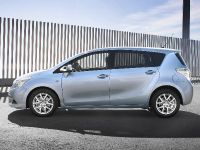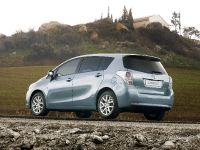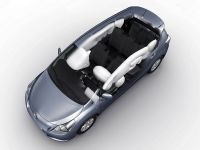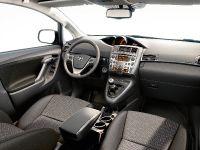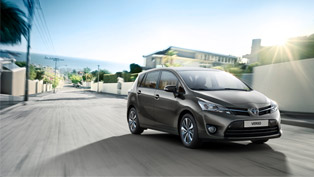World Premiere Of The New Toyota Verso
Toyota Verso is a no-compromise choice for compact MPV customers. It is true to what the term MPV stands for – a multi-purpose vehicle – but doesn't ask the motorist to make sacrifices where style, comfort, quality and driving pleasure are concerned. Combining practicality and safety with desirability, Verso will appeal to customers who want and expect more than just a functional car.
Verso builds on the strong visual appeal of the model it replaces with a more dynamic design. It also benefits from greater levels of comfort, superior standard safety features, more interior space for passengers and their luggage, and, thanks to an engine range that features Toyota Optimal Drive technology across the board, it gives a more dynamic driving experience while maintaining class-leading emissions levels.
Masato Katsumata, Chief Engineer of Verso, explained the objectives of the product development: "In developing Verso we gave it an exterior design that expresses sportiness and stability, and a fresh interior with excellent convenience and attention to detail. We also pursued a high level of comfort and usefulness that we believe will be appreciated by European owners.
"Verso has a wide range of interior storage points and user-friendly flexibility that allow it to respond easily to the varying needs of different owners. Handling performance has been enhanced and, with support from our European engineering teams, the vehicle has been fine-tuned to ensure it gives stable and smooth performance on every type of European road."
Verso combines modern styling inside and out with space, comfort, practicality and flexibility. Class-leading safety provisions, ride quality, acoustic comfort and dynamic abilities match those of a conventional passenger car.
The interior is all, with more space, comfort and an improved Easy Flat-7 folding system for the five rear seats that is easier to operate. Special attention has been paid to improving accommodation for all rear seat passengers, while there is significantly more room behind the third row of seats for load carrying.
Toyota Optimal Drive technology has been introduced throughout the range, increasing engine power by up to 20 per cent, while at the same time achieving reductions in emissions and fuel economy of up to 12 per cent. In the UK Verso will be offered with 1.6 and 1.8 Valvematic petrol engines which will have a class-leading combination of power and CO2 emissions. These will be offered with a six-speed manual transmission as standard, with the option of Toyota's Multidrive S continuously variable transmission on the 1.8 unit. A revised version of the 2.0-litre D-4D diesel will also be available, with a 2.2 D-CAT engine with six-speed automatic transmission due to join the line-up later in the year.
Verso is designed to achieve a maximum, five-star rating in the Euro NCAP crash test programme, thanks to upgraded active, passive and pedestrian impact safety features and a highly rigid, impact absorbing body shell that makes greater use of high tensile steel. Notably all Verso models will be equipped with curtain shield airbag protection for passengers in the third row of seats and with intelligent steering assist Vehicle Stability Control (VSC+).
Capitalising on an investment of more than €1 billion and reinforcing the Adapazari plant's reputation for exceptional build quality, the car will be built by Toyota Motor Manufacturing Turkey.
DESIGN
- ‘Dynamic Lounge' interior concept
- Dual-Zone exterior design
- ‘Smart Wave' interior
- Improved Easy Flat-7 system
- Improved noise, vibration and harshness performance
Toyota's ‘Dynamic Lounge' concept for Verso focuses on all the key attributes of a C-segment MPV to ensure the car combines contemporary exterior and interior styling with the ultimate in space, comfort, practicality and flexibility, class leading occupant and pedestrian safety features, and the ride quality, acoustic comfort and dynamic abilities of a conventional passenger car.
The ‘lounge' element of the concept can be witnessed in the comfort, quality, convenience, atmosphere and roominess of the all-new interior, while Verso's ‘Dynamic' content is expressed through powerful external and interior design elements and strong driving dynamics.
Exterior Building on the dynamic character of the current model,Verso takes Toyota's design language a stage forward with Dual-Zone exterior styling.
This approach is expressed in the car's profile view, with a strong character line flowing from the edge of the front bumper, rising through the lower edge of the doors and sweeping up through the C-pillar to the roof-mounted spoiler. On one side of this line Zone I takes in the bonnet and cabin, and on the other Zone II embraces the chassis and boot space.
From the front,Verso is characterised by forward-flowing lines and a powerful stance, emphasised by the horizontal lines of the twin-bar grille, headlamps that are pulled tightly back into the wings, a deep air dam and a prominent, central Toyota emblem.
In profile view, the sharply delineated front wheelarches complement the dual-zone character line, blending into the upper wings and generating a second character line that runs through the aerodynamic door handles along the vehicle's waistline.
Dimensions have been increased, giving Verso a wider and lower stance. Overall length is greater by 70mm at 4,440mm and width is increased by 20mm at 1,790. Overall height remains 1,620mm and the drag coefficient (Cd) of 0.295 is best in the car's class. Verso remains one of the most compact seven-seat MPVs on the market.
Verso will be offered in a range of colours, together with new-design 16-inch wheel covers and 16 and 17-inch alloy wheels.
Interior Toyota designers describe the interior theme as Smart Wave Dynamism, expressed most strongly in the wave-like form of the upper instrument panel, which distinguishes the functional character of the driver's zone from the more relaxed ambience of the passenger zone. The two zones are linked by a crisp wave line that runs the full width of the fascia.
The speedometer and tachometer are set into individual cylinder housings, angled towards the driver and slightly offset so as not to interfere with the driver's view of the road ahead. The gear lever is mounted close to the steering wheel on a centre console that provides a strong vertical definition of the driver's zone.
Puddle lights are integrated in the door mirrors, which illuminate as you approach and unlock the vehicle with the key fob, with soft orange LED lighting activated in the front footwells as the doors are opened.
Titanium-look inserts are featured on the door handles, steering wheel and centre console and there is a blend of soft-touch technical grain plastic for the upper dashboard, with leather grain effect on the darker, lower section, accentuating the sense of space inside the cabin.
A large panoramic glass sunroof with integrated electric blind is also available, increasing the open and airy cabin atmosphere. It extends from the head of the windscreen to beyond the B-pillars, measuring 1,160mm long and 1,180mm wide. It is the largest one-piece roof of its kind in Verso's class. The blind can be opened to any point along the length of the sunroof.
Toyota Easy Flat-7 Verso offers all the versatility MPV buyers demand, in a more user-friendly way than ever before thanks to improvements to the Toyota Easy Flat-7 system.
Toyota Easy Flat-7 allows the five rear seats to be individually folded to carry extra passengers or increase load space as the occasion demands; in all 32 different seating permutations are possible.
In Verso Easy Flat-7 has an improved mechanism that returns the second row seatbacks to their original position after being folded to give access to the third row. The headrests on the second and third row seats have a low-profile L-shape to make the seat folding operation easier and improve rearward visibility from the driver's seat.
The third row seats can now be stowed or erected in one easy action, using just one hand with a pull-strap that can be reached from the tailgate. The third row seatbacks also gain a recline adjustment.
The height-adjustable front seats have better shoulder support and a seat base extended by 20mm to improve comfort, particularly on long journeys, while an increase of 40mm in the height of the front seat cushion gives the driver a better view from the wheel.
Support and cushioning have also been improved for second row passengers and a 30mm increase in the seats' sliding adjustment makes access to the third row of seats easier. The couple distance between the front and second row hip points has been increased by 50mm to a maximum 975mm, creating more rear legroom, and the height of the second row seats has been reduced by 35mm to give more headroom and make it easier for passengers to get in and out of the car.
The boot floor is completely flat when the second and third row seats are folded and is longer by 185mm at 1,830mm, making it easier to load long items. The cargo space is also wider by 240mm at 1,585mm, increasing storage capacity from 63 to 178 litres when all rear seats are in the upright position, compared to the current model. The result is a seven-seat MPV that can carry all passengers in comfort, with ample space for luggage, too.
A boot management system is located under the rear loadspace, handy for keeping valuable items out of sight or stowing the tonneau cover. Its capacity varies according to how many rear seats are in use, and whether a full-size or space-saver rear wheel is specified.
Generous storage throughout the car also includes a large double-deck glovebox, an overhead console, generously proportioned door pockets, fold-out seatback tables with cupholders, a spacious centre console box, a drawer beneath the front passenger seat, second row underfloor storage and driver and passenger pockets for holding mobile phones or music players.
Noise, Vibration and Harshness Special attention has been paid to reducing NVH levels in Verso to best-in-class levels for a C-segment MPV, comparable to those for many D-segment passenger cars.
As well as using traditional acoustic damping techniques, Verso marks the world-first application of a two-piece upper and lower liner on the cabin side of the bulkhead. Density of the liner is optimised only at the most critical points to avoid any necessary weight gain. A second acoustic liner on the engine side of the bulkhead combines with under-bonnet insulation to further reduce engine noise intrusion.
Tuned floor silencing panels are installed beneath the seats and in the spare wheel well, and a acoustic material is used for the first time in a Toyota to insulate and absorb noise in the footwells.
Cruciform bracing that ties the instrument panel structure to the A-pillar, crossbeam and floor helps minimise dashboard vibrations. A second beam, bracketed to the floor, runs across the car beneath the rear seats. Wheelarch liners and resin rocker mouldings help reduce stone chip clatter and an insulator between the A-pillar and inner wing further isolates the cabin from noise intrusion.
These measures combine with an aerodynamics package that gives a class-leading drag coefficient (Cd) of 0.295 to reduce cabin noise significantly (by 2.5dBa) compared to the current model.
TOYOTA OPTIMAL DRIVE POWERTRAINS
- Toyota Optimal Drive technology applied to full engine range
- Power increased by up to 20 per cent, CO2 emissions and fuel economy reduced by up to 12 per cent
- Valvematic 1.6 and 1.8 petrol engines with six-speed manual and Multidrive S transmissions
- six-speed automatic transmission for 2.2 D-4D 150 diesel engine – due later in 2009
Verso benefits from Toyota Optimal Drive, adopting innovative technologies to minimise fuel consumption and CO2 emissions, increase power and maximise driving pleasure.
These diverse core technologies focus on three aspects of powertrain development:
- The reduction of powertrain weight through the use of super-lightweight and highly compact engine components and transmissions.
- The minimisation of mechanical losses through the adoption of Valvematic (a further development of VVT-i),roller rocker technology, smaller and lighter pistons, low viscosity oil and six-speed manual and Multidrive transmissions.
- The maximisation of combustion efficiency, achieved by adopting high compression ratios, refinement of intake port and combustion chamber design and the introduction of oil jet piston cooling. All Verso diesel engines benefit from an upgraded fuel injection system.
Three engines will be available in Verso at launch in the UK: two petrol engines, 1.6 and 1.8-litre Valvematic units, which give a best-in-segment combination of power and CO2 emissions; and a revised 2.0-litre D-4D 130 diesel. A 2.2-litre D-4D 150 D-CAT diesel will join the range later in 2009 with a six-speed automatic transmission.
The 1.6-litre Valvematic is matched to a six-speed manual transmission. Compared to the 1.6 VVT-i engine featured in the previous generation Verso, power has been increased by 22bhp (22 DIN hp) to 131bhp (132 DIN hp), and maximum torque by 10Nm to 160Nm at 4,400rpm. Provisional figures show CO2 emissions down by 17g/km to 161g/km and combined cycle fuel consumption improved from 37.7 to 41.5mpg.
The 1.8-litre Valvematic engine offers the choice of the six-speed manual gearbox or Multidrive S, Toyota's latest continuously variable transmission technology. It marks significant improvements in power, torque, emissions and fuel economy over Verso's previous 1.8 VVT-i unit: power is up by 18bhp (18 DIN hp) to 145bhp (147 DIN hp), torque increases by 10Nm to 180Nm at 4,600rpm; CO2 emissions are down 19g/km to 165 g/km (manual), and combined cycle fuel consumption improves from 36.7 to 40.4mpg (provisional CO2 and mpg figures).
With the Multidrive S transmission, CO2 emissions are expected to be 164g/km and combined fuel consumption 40.4mpg, figures which represent the system's advantages over conventional automatic transmissions.
Verso also gains a revised 2.0-litre D-4D diesel engine that develops a maximum 125bhp (126 DIN hp) and 310Nm from 1,800 to 2,400rpm, with 140g/km CO2 emissions, a best-in-class figure for the core 110-140bhp power range in the seven-seat MPV C-segment.
The 2.2-litre diesel engine featured in the current Verso range is carried forward for the model and will be available to UK customers later in 2009. Output is increased to 148bhp (150 DIN hp), and maximum torque up to 340Nm, available from 2,000 to 2,800rpm. Equipped with Toyota D-CAT clean diesel technology, it produces 178g/km of CO2 and returns 41.5mpg in combined cycle driving (provisional figures). This engine will be matched to a six-speed automatic transmission.
Ride and Handling
- Greater stability with longer wheelbase and wider front and rear track
- Class-leading aerodynamics – Cd 0.295
- Revised suspension geometry
- Electric Power Steering with active steering force compensation
- Improved braking system
Verso has been designed to give the agile handling, body control, stability and ride comfort of a conventional passenger car with its all-new high-rigidity body shell, longer wheelbase, wider front and rear tracks and extensively revised suspension geometry.
Aerodynamics Verso has a class-leading drag coefficient of 0.295 thanks to a carefully judged design that is fundamental to the car's body control, high speed stability and reduction of wind noise.
Particular attention has been paid to the flow of air beneath the car, with a smooth underfloor, wheel spats and wing-shaped vertical fins contributing to the control of vertical body movement and optimisation of front and rear lift coefficients. The result is a flatter straight-line ride, more controlled yaw response and better rear stability, notably in cross-winds.
Suspension The MacPherson-type front suspension has a set-up with dual top mounts: a stiffer, outer mount locating the spring and a softer inner mount locating the damper. With increases in the caster angle and roll rigidity, the format gives optimum handling with low noise transmission and excellent ride comfort.
The compact, lightweight rear torsion beam with integrated anti-roll bar has also been revised with adjustment to trailing arm angle to improve steering response. The spring and damper mounts have been separated to improve packaging efficiency, ride comfort and handling.
Electric Power Steering For the first time in Europe, Toyota has added active steering force compensation to its variable assistance Electric Power Steering in Verso. If the system detects a steering input speed that is too high for the required vehicle response, it will automatically reduce power assistance delivery to limit the input and so promote smoother driving.
When the steering column torque sensor detects vibration from the wheels, an active vibration control programme with the ECU can produce a compensating signal to reduce the vibration before it reaches the steering wheel.
Brake and Tyres Verso is equipped with the latest ABS and VSC+ braking and stability systems, incorporating electronic Brakeforce Distribution (EBD) and Brake Assist (BA) to give much shorter stopping distances.
SAFETY
- Designed to achieve five-star Euro NCAP crash test rating
- ABS with EBD and BA, steering assist Vehicle Stability Control, Traction Control and Hill-start Assist Control standard on all versions
- Seven airbags, including curtain airbag protection for third row passengers
- Improved pedestrian impact safety
Verso benefits from upgraded active, passive and pedestrian impact safety features and has a highly rigid, impact-absorbing body shell with a higher proportion of high tensile steel. These elements are designed to earn it a top five-star rating in the, more stringent Euro NCAP crash test programme.
Active Safety A full range of active safety systems are available for Verso, including the latest-generation ABS with Electronic Brakeforce Distribution (EBD) and Brake Assist (BA).
The intelligent steering assist VSC+ system, fitted as standard, counteracts under or oversteer by independently applying braking force to any of the four wheels, while simultaneously generating counter-steering torque to help the driver bring the car under control. Traction Control (TRC) contains wheelspin and Steering Torque Assist counters vehicle yaw moments under braking or acceleration.
Hill-start Assist Control (HAC) provides extra control when pulling away on a gradient, preventing the vehicle from rolling backwards.
Passive Safety Seven airbags are fitted as standard: driver front passenger front and side airbags, front passenger knee airbag; and curtain shield airbags that extend the full length of the cabin to protect occupants in both rows of rear seats – a feature that is rare in the compact MPV segment.
The front seats have active anti-whiplash headrests and all seats are linked to a seatbelt reminder system on the instrument panel. Further protection against leg injuries is provided for driver and front passenger by energy-absorbing pads built into the front footwells.
Side impact forces are channelled across the floorpan and through roof strengthening members and, in a first for a Toyota vehicle, energy absorbing pads are located on the door belt line and rear passenger hip point to reduce injuries.
A high-resistance seat rod is positioned beneath the rear seats and secured on each side of the cabin, further helping to absorb side impacts.
Pedestrian Impact Safety Verso's bonnet has an energy-absorbing structure and a crushable cowl at its rear edge. The wiper motor and linkage have been relocated lower down on the firewall, further away from the point of impact should a pedestrian be hit.
The bonnet lock is set well down from the upper bonnet surface and the construction of the front end of the car incorporates upper and lower leg impact absorbers, with additional absorbers located where the rear edge of the bonnet meets the upper part of the fender.
Equipment Specifications Equipment grades and specifications for Verso in the UK will be announced nearer the car's on-sale date in April.
All models will be equipped with seven airbags, including side airbags for third row passengers; active front headrests; steering assist Vehicle Stability Control (VSC+) and Hill-start Assist Control (HAC), LED rear lights, puddle lights, an overhead console, underfloor storage, boot organiser and an additional rear view mirror so the driver can keep an eye on younger rear seat passengers.
Other features and options that will be available according to grade include Bluetooth, manual or climate control air conditioning, a cooled glovebox, cruise control, 16 or 17-inch alloy wheels, rain and dusk sensors for the wipers and headlights, full map satellite navigation with a 10Gb hard disk drive and rear parking monitor and panoramic sunroof.


